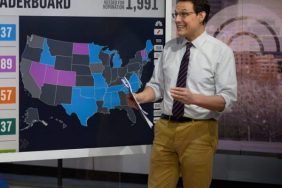Photo: A Native American tribesman, © Fox Photos/Getty Images.
Christopher Columbus ran a scam that began in 1492, when King Ferdinand and Queen Isabella of Spain agreed to finance three ships to cross the Atlantic Ocean in search of a western route to Asia. He made four crossings over then next 11 years, the first of which brought him to the Bahamas, populated by the Taíno, a peaceful and friendly tribe of indigenous people.
Also: 5 Things You Need to Know About Standing Rock
Of the Taíno, Columbus wrote, “They traded with us and gave us everything they had, with good will … they took great delight in pleasing us … They are very gentle and without knowledge of what is evil; nor do they murder or steal…Your highness may believe that in all the world there can be no better people … They love their neighbours as themselves, and they have the sweetest talk in the world, and are gentle and always laughing.”

Landing of Christopher Columbus at San Salvador, on October 12, 1492, 19th-century illustration.
He noted that they lacked modern weaponry, and told the King and Queen, “I could conquer the whole of them with 50 men, and govern them as I pleased.” Tragically, he did just this. Between 1494 and 1508, the Taíno of the Caribbean was decimated, as 80-90% of natives were killed during by war, slavery, and disease. His troops were savages, stealing, killing, raping, and torturing the Taíno in search of imaginary treasure houses. Columbus instituted the transatlantic slave trade in 1495, shipping more than 5,000 Taíno to Europe. He also started sex slavery, selling girls as young as nine years old, noting that children were of particular demand to the Spanish colonists.
Columbus played both sides of the fence, as quick to exploit the colonists as the natives. Accusations of tyranny and incompetence against the colonists reached the Spanish court. Columbus was deposed and brought to trials for his crimes. More than 23 people, including his supporters, testified against him and his brothers. They were arrested and imprisoned, but later freed and given a second chance for Columbus’s fourth and final voyage across the ocean.
He finally died at the age of 54, and faded into the annals of history for the most part, until he was widely resurrected in 1893 at the World’s Columbian Exposition, otherwise known as the Chicago’s World Fair, to celebrate the 400th anniversary of his arrival on Bahamian shores. The facts were conveniently erased, and a new history was written in its place as President Benjamin Harrison called upon the people of the United States to celebrate Columbus Day as a symbol of national pride. Teachers, preachers, and politicians alike saw Columbus Day as the perfect opportunity to ritualize patriotism. In 1937, President Franklin Delano Roosevelt and Congress made it a federal holiday, after bowing to the lobbying of the Knights of Columbus, an influential Catholic group seeking recognition and status of Italian Americans.

Petroglyphs at Signal Hill near Tucson, Arizona © Freerange Archives (CG Collection)
However, not all states recognize Columbus Day. Hawaii, Alaska, Oregon, and South Dakota have forgone it completely, while California and Texas do not give government workers a paid day off. The tides against Columbus Day had begun to turn, and a new holiday was proposed.
Beginning in 1992, the city of Berkeley, CA, replaced Columbus Day with Indigenous People’s Day to honor the First Peoples on the 500th anniversary of Columbus’s arrival. The holiday promotes the history and culture of Native Americans, who have populated North America for more than 16,000 years and now make up less than 2% of the U.S. population. More than 25 cities are now taking part, including Portland, Phoenix, Santa Fe, Albuquerque, Denver, Boulder, Cambridge, St. Paul, Seattle, and Olympia—and just last Thursday, Vermont Governor Peter Shumlin signed a proclamation renaming Columbus Day as Indigenous People’s Day.
In celebration, we encourage you to check out the inspiring, empowering, and often heartbreaking histories of the First Peoples in the Western hemisphere, including 5 Things You Need to Know About Standing Rock, Donald Ellis Gallery: Plains Indian Ledger Drawings 1865–1900, Myth and Majesty: Photographs Picturing the American Southwest, Jonathan B. Wittenberg: Navajo Nation 1950, Edward S. Curtis: One Hundred Masterworks, Virgil Ortiz: Revolt 1680/2180, and The Lost Tribes of Tierra Del Fuego: Selk’nam, Yamana, Kawésqar.

© Jaime Burciaga
Miss Rosen is a New York-based writer, curator, and brand strategist. There is nothing she adores so much as photography and books. A small part of her wishes she had a proper library, like in the game of Clue. Then she could blaze and write soliloquies to her in and out of print loves.




